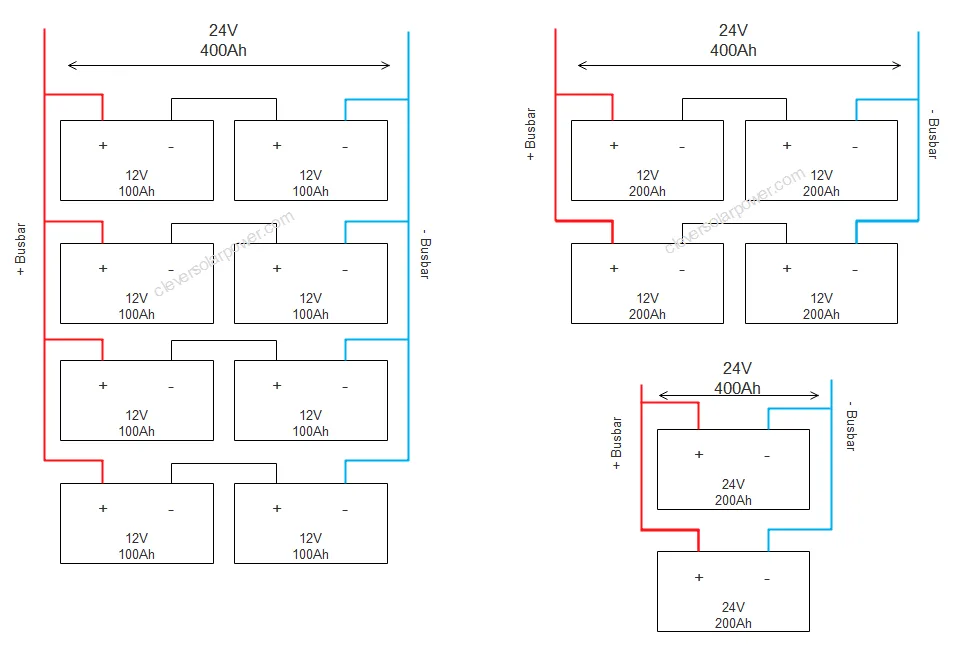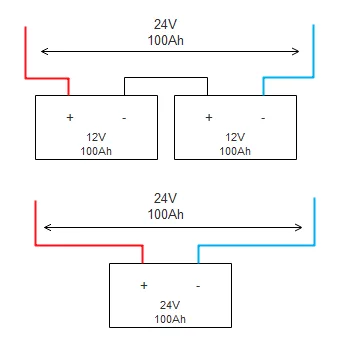You are here because you want to know how many batteries you need to run a 2,000W inverter.
At the end of this article, you will know exactly how many batteries you need and which configuration (with diagrams).
- Lead-acid battery: 24V 400Ah
- Lithium Battery: 24V 100Ah
Let me explain how these values are calculated:
Battery Voltage
The first we need to know is what battery voltage you will use.
- 12V
- 24V
- 48V
Here are the advantages of a higher battery voltage:
- Less current, meaning cheaper wires
- More efficient conversion in the whole system
- Less voltage drop
Limiting System Current
If we build a DIY system, I recommend limiting the current to 100A. This is because of safety reasons of a DIY installation, and it will save you money. Here are the recommended battery voltages with corresponding inverter sizes:
- 12V battery: Max 1,200W inverter
- 24V battery: Max 2,400W inverter
- 48V battery: Max 5,000W inverter
- More inverter capacity: inverters in parallel
Battery Capacity and C-rate
Now that you know you should use a 24V battery to run a 2,000W inverter, we can look at the capacity and the C-rate.
The capacity of the battery is indicated in amp hours or simply Ah. The most common battery will be 12V and 100Ah.
The battery capacity ties in directly with the C-rate of the battery. The C-rate indicates how fast we can charge and discharge a given battery. There are two kinds of batteries we tend to work with. These are:
- Lead acid
- Lithium (LiFePO4)
Both of these have a different C-rate.
- Lead acid: C-rate of 0.2
- Lithium: C-rate of 1
Let’s use an example of a 12V 100Ah lithium battery (1C). If we multiply the battery capacity with the C-rate, we can see that this battery can deliver a current 100A.
100Ah x 1C = 100A
If you want to learn more about C-rate, watch my video about it here
Now, if we’re going to figure out how much power (watts) this battery can deliver, we need to multiply the recommended C-rate by the battery voltage:
100A x 12V = 1.200W
Now you can see we can only have a 1.200W inverter with a 12V 100Ah lithium battery.
Now that we know how the math works, we can use these calculations on a 2,000W inverter.
Don’t know which inverter to get? Check out my article about the best off-grid inverters.
How Many Batteries do I Need for a 2000-Watt Inverter?
We will split this section up in two parts. one for Lead-acid batteries and one for lithium (LiFePO4) batteries.
How many lead-acid batteries are needed for a 2,000W inverter?
If we divide 2000W by 12V we become 166A. This is too much for a DIY system, so we will use a 24V system.
2,000W / 24V = 83A
We can see that 83A is perfect (100A fuse), and the wiring will be half as thick as if we were to use a 12V system.
Now, the C-rate of lead acid is 0.2C. This means that we need a high-capacity battery for this to work.
Having a low battery capacity will still work, but the lifetime of the batteries will suffer. Therefore, we need to size according to these values.
83A / 0.2C = 415Ah
We can see that we need a 24V battery with a capacity of 415Ah. This means we need:
- 8 pcs 12V 100Ah lead-acid battery
Or
- 4 pcs 12V 200Ah lead-acid battery
Or
- 2 pcs 24V 200Ah lead-acid battery
Here are the wiring diagrams for these battery systems:

How many lithium batteries are needed for a 2,000W inverter?
The first calculation will be the same as the lead-acid battery. We will still use a 24V battery system.
2,000W / 24V = 83A
The c-rate of a typical lithium (LiFePO4) battery is 1C.
83A / 1C= 83Ah
So our 24V battery needs a capacity of 83Ah to work efficiently. We need the following batteries:
- 2 pcs 12V 100Ah lithium battery
OR
- 1 pc 24V 100Ah lithium battery
Here are the diagrams for these configurations:

Conclusion
We can see that we need fewer lithium batteries than lead-acid batteries. This is because the C-rate with lithium is higher.
We need a 24V system if we want to run a 2,000W efficiently.
- If we have a lead-acid battery we need a total battery of 24V 400Ah
- If we have a Lithium battery, we need a total battery of 24V 100Ah

I’m an off-grid enthusiast. I created this website to give clear and straight-to-the-point advice about solar power. I’m also the author of the book ‘Off-grid solar power simplified‘. Read more about me on my about page, check out my Youtube channel, or send me a message.
Hi Nick it’s Ashfaq from Botswana, I want to know something, is 2 250ah gel batteries enough to run a fridge on a 3000w inverter
Hello Ashfaq, at the end of this article you will find a link for a 3,000W inverter.
If you do not draw more than the fridge (600W peak) then it will be ok.Keep in mind that a 3000w inverter has more idle consumption than a smaller inverter. So I would recommend downgrading to a 1000W inverter if you have the option.
I assume you put them in parallel to make a 12V 250Ah battery? (250Ahx0.2C=50A -> 50Ax12V=600W -> ok)
If I see an application that requires a 2000W generator, like a window AC unit, does that mean I just need a 2000W battery/inverter system? Or are there differences?
I assume you mean to consume 2000W of power, not a generator. It depends on the type of load. A window AC units has a high starters current, thus you cannot run it on a 2000W inverter. You need a low frequency inverter to run inductive loads. 2000W will be fine to power electronics like tv’s and computers. Read my article about low and high frequency inverters here.
Hi Nick! Thanks for putting this together! Do your numbers factor in the usable WH and usable capacity before charging? For example, in the lead-acid scenario, if we only want to discharge the batteries to 50%, what would be the longest time we could power 2000watts continuously (assuming an inverter efficiency of 90%, and any other factors you feel are necessary to consider) ?
It would still be the same, but you can only run the appliance for half the time. Assuming a 24V 400Ah lead-acid battery like the one I recommend, we will have a total energy capacity of 9.600Wh/2= 4.800Wh of usable energy. 4.800*0.9 inverter efficiency*0.85 batt efficiency = 3.670Wh. Now we calculate the total running time: 3670Wh/2000W=1.8 which is 1 hour and 48 minutes. The efficiency of the lead acid battery is 85% which is the total energy lost from putting it in the battery to pulling it out from the battery. So we can say the runtime will be about two hours.
Hi I need help. I have a solar system in caravan, was there when i bought it 7 years ago. Inverter now not working properly, i have no idea what power the inverter is. Its an Opti-Solar. I have 4 100ah batteries in parallel and 3 x 200w solar panels *600W* could you tell me what you would advise as a new inverter for this.. 1000w? 2000W? or 3000W? Ive contacted more than 10 solar installers with this question and nobody will get back to me. Its urgent i get my solar fixed and running, but i have no idea what Inverter size i need.., thanks
You have a battery of 12V and 400Ah. If your batteries are lead acid then max 1000W inverter (400Ah*0.2=80A*12V=960W). If your batteries are lithium, then max 2500W depending on the battery type 1C or 0.5C (100Ah*0.5=200A*12V=2400W). You can repeat the calculations that are listed on the page.Try to limit your current to 100A, otherwise increase your voltage.
oh THANK you Nick.. finally an answer.. my batteries are Acid. I was on the brink of desperation to buy a 3000w.. you saved me a lot of money and pain.. thank you thank you thank you… ive contacted nearly 10 now solar installers and no one will reply, and only 1 on facebook who did *not you*, who only wanted my contact details to design a system for me.. :\ thank you again, God bless you and yours
High Nick,
Many thanks for sharing this information.
It is recommended to below 100A, another fact is that in a van wi have an alternator of 12V. What installation do you recommend to work with 12V but having a higher power, let us say for instance 3,000W? Many thanks
It’s best to use a 24V battery bank and use a victron Tr-smart 12-24V device. Make sure it’s TR-smart and not a DC-DC converter, these don’t charge batteries. Check my video about voltages in RV’s here: https://youtu.be/-OP0aEPgzqs
Hello, is it possible to add capacity to a 24V/2000w inverter system beyond 2400wh to add more batteries to the bank? Or would a higher rated inverter be needed? For ex if I wanted to have three 12V 100ah batteries with a 2000w inverter.
Does a 3000w inverter need 48v or can it be run as 24v?
You need to keep in mind the C-rate of the battery. If the discharge current is higher than the batteries C-rate, you have not sized your system well. Repeat the calculations shown in this article with your own system. You cannot use a 48V inverter on a 24V system.
Nick, I am customizing a 6×10 enclosed trailer for a friend who will use it for primitive camping, totally off grid.
A 1500 watt inverter should be plenty. A mini-fridge, a few lights, a laptop, and cell phone charger. I would like to be able to charge the battery off the towing vehicle. And possibly a solar trickle charge?
Thanks
Jeff
I would use a DC to DC charger from the alternator to a lithium battery. Maybe add a solar panel, but most of the charge comes from the alternator.
Hello Nick, I am glad I came across your articles. I have a 2000w/24v system and I have 4 6V/200ah batteries. Is this sized correctly and is the set up efficient?
2000W/24V=84A –> 24V 200Ah lead-acid battery at 0.2C rate should only draw 200Ah*0.2C=40A. So you should have a max of 1000W inverter. 2000W will work of course, but it’s not ideal.
So glad I found someone who is willing to help a solar illiterate such as myself. I bought 4 100w solar panels, a Victron 100/30a scc, a 2000 watt inverter to be connected to two 12v 100ah lithium batteries in parallel to give me 24v. Am I on the right track?
Charge controller is properly sized, make sure the positive of battery 1 is where your inverter positive connects and the second battery negative is where your inverter negative connects (current sharing). Check out my youtube channel for more: https://www.youtube.com/@cleversolarpower
I have 2 X 138 AHR AGM batteries, running a 25 amp DC DC Charger and a 2000 watt inverter. I have a 110 watt solar panel on the roof of my poptop and a 200 watt blanket I can hook up in minutes. I have a 2kw diesel heater, 6 X 3 LED lights, 2 low wattage fans,
1 X 16 litre compressor fridge, 1 X 20 litre which will be used as a freezer, and phone and 10 inch Android tablet. the above run off accessory and USB plugs. i have been advised to use 10 mm wire to hook everything up including batteries in parallel. the confusing part, is this suff and what wattage does the fuse between batteries need to be to safe please? i have a 30 amp solar controller.
Please watch my video about it: https://youtu.be/Kac94bw5dmM